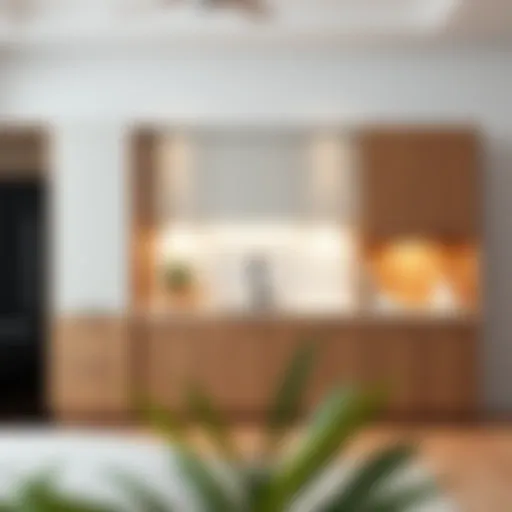Integrating Tall Potted Plants in Modern Interiors
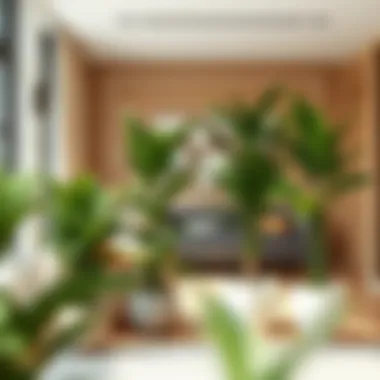

Intro
In the evolving landscape of interior design, one element consistently proves to be both a stylish statement and a vital component of a home’s ambiance: tall potted plants. These botanical beauties not only breathe life into a space but also serve as a bridge between the natural and constructed environments. Their vertical presence can draw the eye upward, creating an illusion of height and spaciousness. Imagine stepping into a room adorned with a majestic Fiddle Leaf Fig or a classic Rubber Plant, where greenery brings warmth and vitality to modern aesthetics.
The integration of tall potted plants into modern interiors is more than just a fleeting trend; it represents a shift in how we perceive our living environments. With an increasing emphasis on sustainability and well-being, homeowners and designers alike are turning to greenery for both aesthetic and practical benefits. From purifying the air to enhancing mood, the role of these plants extends beyond mere decoration.
This article provides an in-depth exploration of how tall potted plants can transform interiors, highlighting their design impact, offering care tips, and guiding readers on how to skillfully incorporate greenery into their spaces. Whether you’re a designer looking to elevate a project or a homeowner eager to bring the outdoors in, this guide aims to enrich your understanding of these green giants in modern interior design.
Furniture Styles and Trends
Tall potted plants can seamlessly blend into various furniture styles, enhancing the overall aesthetic and functionality of a space. Let’s explore how these plants operate within different design contexts.
Modern vs. Traditional: Understanding the Aesthetics
In modern interiors, where minimalism reigns, tall potted plants serve as focal points that add warmth without cluttering a space. Clean lines are complemented by the organic shapes of foliage, creating a harmonious balance. On the other hand, traditional homes may welcome lush greenery that echoes classic design elements. Consider pairing a tall palm with a vintage armchair or positioning a snake plant next to a rustic side table. The interplay of old and new can bring a lively dynamic to any room.
Color and Material Trends: What's In and What's Out
When selecting pots for these towering plants, the color and materials used can significantly impact the overall design. Currently, earthy tones and natural materials like terracotta and ceramic are gaining traction, providing a rustic vibe that is both trendy and timeless. In contrast, shiny metallic finishes and bold colors might fit well in contemporary settings. The key is to ensure that the style of the pot complements the plant and the surrounding decor, creating a cohesive look.
The right tall potted plant can turn an overlooked corner into a vibrant centerpiece.
In summary, understanding how tall potted plants interact with various furniture styles and color trends is paramount. By selecting the right plant and pot combination, homeowners can elevate the design narrative of their spaces, blending functionality with visual appeal.
Prelims
In today's era, where the hustle and bustle of daily life can feel overwhelming, creating a tranquil and visually appealing home environment has becoming imperative. Tall potted plants emerge as an integral element in modern interior design, offering both aesthetic and functional advantages.
These plants serve as more than just decor. They introduce a connection with nature that is often absent in urban living. Picture a spacious living room adorned with a towering Fiddle Leaf Fig or a cozy corner brightened by a Rubber Plant—the visual impact is undeniable. Understanding how to integrate these botanical companions into your living spaces can transform a mundane area into a vibrant sanctuary.
Moreover, tall plants bring life to corners often forgotten, elevating the overall atmosphere of a room. They can soften sharp edges of furniture, draw the eye upwards, and create a feeling of volume and openness. The right selection of plant not only enhances aesthetics but also complements various interior styles, facilitating smooth transitions across different zones of a home.
Choosing tall potted plants involves careful consideration of several factors. Light conditions, humidity levels, and size are crucial in ensuring the health and longevity of your plants. Neglecting these elements can result in plants that struggle to thrive. Even the most breathtaking species can falter if placed in an unsuitable environment.
In this article, we will explore the role of tall potted plants within modern interiors thoroughly. From their aesthetic contributions to practical considerations and care tips, this guide aims to equip homeowners, designers, and enthusiasts with the insights necessary to make informed choices. Therefore, let’s dive into the captivating world of tall potted plants and unravel how they can enhance your living spaces effectively.
The Aesthetics of Tall Potted Plants
Tall potted plants have made a notable leep into the heart of modern interior design, offering vibrant blends of aesthetics and nature. Their presence can redefine a room, transforming it from mundane to extraordinary. When you walk into a spacious living room or a compact office, the mere sight of tall greenery draws the eye, elevating the visual appeal of the space and adding layers of depth and texture. It’s not simply about beautifying a corner; it’s about creating a connection with the natural world, even indoors.
The core importance of tall potted plants extends far beyond their ornamental value. There’s a critical role they play in setting the ambiance of a place. Think of it as a conversation starter; the right plant can influence how a space feels—cozy or airy, wild or structured. They draw on a myriad of design principles, from color theory to the balance of proportion, allowing homeowners and designers alike to express creativity and individuality in their setups.
When decorating with tall potted plants, one must consider their color, form, and arrangement. For instance, a slender, elegant plant can fill the vertical space effectively in a high-ceiling room, while a wider plant may ground a space, providing a sense of stability. Choosing the right pot is equally essential; the material and color of the pot can either complement the plant visually or create a striking contrast that makes the arrangement pop in its own right.
Visual Impact in Spaces
Visual impact is perhaps the most tangible aspect of tall potted plants. They serve as focal points in a room, guiding the eye and creating pathways through the space without needing to put an over-the-top artwork on the wall. The strategic placement, whether in a corner, beside furniture, or even in a window, can draw attention or help frame the views.
"Plants can uplift any space, giving it personality and warmth."
Another important element is the variations in leaf shape and texture. For instance, a tall snake plant with its rigid leaves can create a striking contrast with soft, cascading foliage of a tall pothos. The interplay of different textures adds richness while evoking feelings of serenity and freshness, often essential in busy urban environments.
Complementing Interior Styles
Tall potted plants can seamlessly integrate into various interior design styles, enhancing their unique characteristics. Let's explore how they align with three popular aesthetics: Modern Minimalism, Bohemian Chic, and Industrial Design.
Modern Minimalism
In the realm of modern minimalism, less is definitely more. This design style emphasizes simplicity and functionality, with clean lines and uncluttered spaces. Tall plants, specifically those like the Fiddle Leaf Fig, with their distinct, large leaves, can punctuate a minimalist interior without overwhelming it. They offer a single point of interest against a neutral backdrop, allowing their natural beauty to shine. Their strategic placement can draw the eye upward, making the space feel taller and evoking a sense of airy spaciousness.
However, choosing the right minimalistic pot is crucial. Opting for a pot that maintains the clean lines reflects the overall aesthetic without distraction. A matte white ceramic or a sleek cement pot can accentuate the natural lines of the plant without taking away from the minimalist philosophy.
Bohemian Chic
Bohemian chic is about blending colors, patterns, and textures, and tall potted plants fit ideally within this vibrant framework. The eclectic essence of this style allows for a mix of textures and designs. Plants like the Bird of Paradise that showcase dramatic foliage can add waft and whimsy to any room.
In this setting, the pots can truly be a statement piece. Ranging from terracotta to hand-painted styles, the pots are often as varied as the plants themselves. The key here is to embrace that sense of adventure—don’t shy from mismatched styles or wild colors. Bohemian designs thrive on a certain level of organized chaos, and tall plants amplify that spirit beautifully.
Industrial Design
Industrial design is characterized by raw materials and utilitarian forms, with a truth-to-materials philosophy that harkens back to factories and warehouses. Here, tall potted plants, such as the Rubber Plant, serve as a greenery counterpoint to the hard surfaces of metal and concrete. They soften the starkness of the industrial environment while bringing a breath of fresh air indoors.
The use of metallic pots or distressed finishes works well in such spaces, creating a rugged yet cohesive feel. Leather and wood accents can further tie in the natural elements while maintaining that ‘rough-around-the-edges’ vibe. This interplay between nature and the industrial feel adds a unique character that speaks volumes about personal style and design sensibilities.
Functional Benefits of Tall Potted Plants
In the journey of creating a harmonious living space, the addition of tall potted plants offers more than just aesthetic appeal. These plants play a significant role in enhancing indoor environments by providing various functional benefits. Their presence can transform the atmosphere, leading to improved well-being while serving practical purposes that many may not initially consider. In this section, we’ll delve into two key functional benefits: air quality improvement and thermal regulation.
Air Quality Improvement
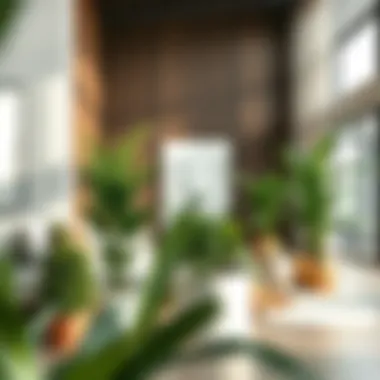

One of the most compelling reasons to introduce tall potted plants into modern interiors lies in their ability to enhance air quality. Plants are a natural air purification solution, operating silently yet effectively, often without us even realizing it. Tall varieties like the Fiddle Leaf Fig or Bird of Paradise can absorb toxins present in indoor air, such as formaldehyde, benzene, and trichloroethylene. This is particularly beneficial in urban environments where pollutants can seep into homes.
Studies conducted by NASA have showcased that certain plants have the capability to remove up to 87% of indoor air toxins within a span of just 24 hours. Isn’t that remarkable? Some of the top performers include:
- Spider Plant: A resilient choice, great for novice plant owners.
- Rubber Plant: Not only attractive but efficient in toxin removal.
- Peace Lily: Known for its lovely blooms while filtering air pollutants.
Incorporating these plants into your home can lead to a fresher, more inviting atmosphere. Furthermore, the presence of greenery often invokes a sense of peace and tranquility, contributing to overall mental well-being. So, it’s safe to say that they aren’t just a pretty face?
"Plants are the lungs of the Earth, but they also play a crucial role in enhancing indoor spaces, making them a vital addition to any home."
Thermal Regulation
In addition to improving air quality, tall potted plants contribute to thermal regulation within a space. During warmer months, these plants can help mitigate excess heat by releasing moisture into the air through a process known as transpiration. This not only cools the air around them but also creates a more comfortable indoor climate.
For example, incorporating a tall, leafy plant such as the Monstera Deliciosa near windows or in sun-soaked areas can provide shade while maintaining a moderate temperature. Similarly, in colder climates, taller plants can act as natural insulators, trapping warmth indoors and providing a cozy atmosphere during chilly months.
Factors to consider when thinking about thermal regulation include:
- Positioning: Place plants near windows to optimize their cooling effects.
- Plant Type: Choose species that thrive in your specific climate conditions, ensuring they can provide maximum benefit.
- Grouping: Placing several pots together can enhance their cooling influence, creating a mini-ecosystem within your living space.
Choosing the Right Tall Potted Plant
When it comes to incorporating tall potted plants into modern interiors, the choices can be overwhelming. Selecting the right plant is more than just picking the one that looks good; it involves various considerations such as the environment in which they’ll thrive and how they will enhance your space. A thoughtful selection can elevate a room’s aesthetic appeal while also contributing to the overall ambiance. This section unpacks what it takes to choose the most suitable tall potted plant for your needs.
Assessing Light Conditions
Lighting is a key player in the life of a plant. Different species require varying amounts of light to flourish. To ensure the longevity of your plant, begin by scrutinizing the light exposure in the area where the plant will reside.
- Bright, Direct Sunlight: If your space receives ample sunlight, consider options such as the Fiddle Leaf Fig or the Bird of Paradise, which thrive in bright conditions.
- Indirect Light: Plants like the Rubber Plant do well under these circumstances, growing well in ambient light without the harshness of direct rays.
- Low Light: If your area isn’t well-lit, you might want to look into hardier options such as the Snake Plant, known for its ability to survive in lower light while still making a statement.
"Understanding the light conditions is crucial; it’s the difference between a thriving houseplant and a wilted one."
It might help to do a quick assessment; take note of sun exposure during different parts of the day. This way, you can better match your chosen plant's needs with your home environment.
Size and Scale Considerations
Selecting the right tall potted plant isn't solely about its height. Understanding the scale in relation to your living space creates harmony. A common misstep is choosing a plant that overwhelms or gets lost in the room. This is particularly prevalent in smaller apartments.
- Large Spaces: In wide-open areas, a Monstera Deliciosa can serve as a showstopper, filling empty corners while complementing high ceilings.
- Compact Spaces: For tighter quarters, consider opting for smaller yet still tall plants, like a Parlor Palm that can add verticality without taking over.
- Proportional Balance: Aim for balance; don’t position a plant that’s too tall next to furniture that’s too small. An ideal ratio enhances both the plant and the furniture within the space.
By contemplating the plant’s size in relation to furniture and room dimensions, you ensure that the integration will be seamless, enriching the overall design rather than detracting from it.
Popular Tall Potted Plants
In the ever-evolving world of interior design, tall potted plants have secured their footing as a favored choice among homeowners and designers alike. These plants are not just decorative elements; they are integral to shaping the ambiance and functionality of a space. When thoughtfully chosen, they can breathe life into any corner, becoming a striking focal point or harmonizing seamlessly with existing decor. The selection of tall plants often boils down to aesthetic appeal, practical considerations, and care requirements, making it crucial for anyone working on interior spaces to understand the most popular options available.
Fiddle Leaf Fig
The Fiddle Leaf Fig, with its broad, glossy leaves, has taken the interior design scene by storm. It possesses a dramatic presence that can instantly uplift the aesthetic of a room. In terms of care, this plant thrives in bright, indirect light and appreciates consistent watering, but not too much—overwatering can be a slippery slope. Additionally, this plant's versatility is noteworthy; it complements modern minimalism and adds depth to more eclectic designs.
Rubber Plant
The Rubber Plant offers a perfect blend of beauty and resilience. Its deep green leaves can add a grounded feel to spaces, making it a favorite among various design styles, including bohemian chic and industrial design. What makes this plant stand out is its adaptability to different lighting conditions. Whether placed in a sunlit spot or a slightly shaded area, the Rubber Plant adjusts well, making it a solid choice for those who may struggle with maintaining consistent light. This adaptability, alongside its relatively low maintenance needs, makes it a popular selection among both novice and experienced plant parents.
Bird of Paradise
For those looking to make a splash, the Bird of Paradise plant is the ultimate showstopper. With its bold, upright growth and striking foliage, this plant can bring a tropical vibe to any interior. It does well in bright, indirect sunlight and requires moderate watering, making it a less demanding companion than one might expect at first glance. Not only does it serve as a conversation starter, but it also evokes a sense of serenity and relaxation, turning any living space into a personal oasis.
"Integrating tall plants like the Fiddle Leaf Fig, Rubber Plant, and Bird of Paradise into your home is akin to framing a masterpiece—each plant can enhance the visual narrative of your space."
Care and Maintenance
Incorporating tall potted plants into modern interior design is one thing, but keeping those plants thriving is another challenge altogether. Care and maintenance play a pivotal role in ensuring that the greenery you choose becomes a flourishing part of your living space rather than a wilted reminder of negligence. Regular attention to these aspects not only enhances the longevity of your plants but also enhances the overall aesthetics of your home. Understanding how to care for your tall potted plants can make the difference between a stunning focal point and a forgotten corner of your room.
Watering Guidelines
One of the most critical elements in plant care is proper watering. This task seems straightforward, yet it requires a keen eye and a basic understanding of plant needs. Overwatering is one of the most common pitfalls, leading to root rot and other serious issues. It’s essential to gauge how much water your tall potted plants need based on their species, pot size, and environmental conditions. Generally, you should stick a finger into the soil about an inch deep — if it’s dry, it’s time to water.
For instance, a Fiddle Leaf Fig prefers a thorough soaking when the topsoil feels dry, but it’s wise to ensure the excess can drain properly.
- Tips for effective watering:
- Use room temperature water, as cold water can shock the plant.
- Water early in the morning or late afternoon to minimize evaporation.
- Invest in a moisture meter if you’re unsure about the soil’s moisture content.
Soil Requirements
The foundation for healthy plant growth lies in the soil. Tall potted plants require well-draining, nutrient-rich soil to thrive. A mix that retains moisture without making the roots soggy is ideal. Many plants do well in potting mixes specially formulated for houseplants that generally include peat, compost, and perlite or vermiculite.
For example, the Bird of Paradise flourishes in a chunky mix that allows for air circulation around the roots, preventing them from suffocating. When refreshing the potting soil, aim to replace about one-third of the old soil with fresh mix annually.
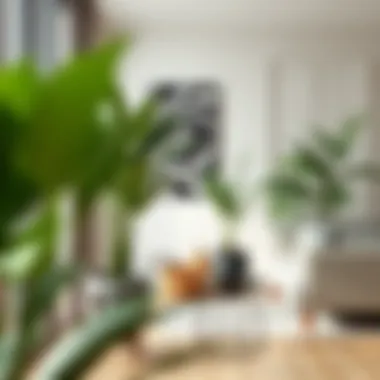

- Soil considerations:
- Ensure the pot has adequate drainage holes to avoid water accumulation.
- Depending on the plant type, consider amending the mix with organic fertilizers to boost nutrients.
Pruning and Grooming
Pruning and grooming are often overlooked but are essential for keeping tall potted plants looking their best. Regularly removing dead or yellowing leaves not only improves the plant’s appearance but also prevents the spread of diseases. Moreover, strategic pruning can encourage new growth and develop a fuller shape.
You should pay attention to the growth patterns of your tall plants. For instance, Rubber Plants tend to grow upwards rapidly, necessitating occasional trimming to maintain a rounded shape.
- Grooming strategies:
- Use clean and sharp tools to make clean cuts and prevent infection.
- Clean the leaves with a damp cloth to remove dust and improve photosynthesis.
Remember: Pruning not only enhances aesthetics but can significantly contribute to the well-being of your plant, ensuring it continues to thrive in your home environment.
Creating a Plant Display
Creating a plant display goes beyond simply placing greenery in a room; it's about designing a narrative that intertwines nature with our living space. In modern interior design, tall potted plants play a crucial role, drawing the eye and creating focal points that imbue a space with life. Thoughtful arrangement deftly balances scale, color, and texture to enhance aesthetic appeal while considering practicality. The right display not only purifies air and boosts mood but can also set the tone for an entire room, whether it’s a serene escape or a dynamic workspace.
From the corner of a cozy living room to the vibrant atmosphere of an office, the key to an effective display lies in recognizing the characteristics of each environment. This section will dive into some specific spaces, examining how to arrange these plants to fully unleash their potential.
Arranging in Rooms
Living Rooms
In living rooms, tall potted plants enhance the cozy and inviting feel that everyone seeks. Their height can draw attention upward, making ceilings feel higher and bringing an enchanting, tranquil vibe to the space. One key characteristic of a living room is its multifaceted nature—it's often a space for relaxation, social interactions, and entertaining guests. This versatility makes it an ideal canvas for tall plants like the Fiddle Leaf Fig or the Rubber Plant, known for their broad leaves and striking appearance.
A unique feature of living rooms is the opportunity to combine natural plants with varied textures such as wood, fabric, and metal. A plant in a sturdy ceramic pot can beautifully contrast with a soft, plush couch. But beware—overcrowding can create a cluttered look instead of a harmonious feel.
Office Spaces
Office spaces benefit significantly from incorporating tall potted plants. They can break up stark lines and sterile decor typical of many work environments, thereby infusing an infusion of nature into daily routines. A notable aspect of office design is achieving balance between professionalism and comfort. Tall plants can serve as perfect eye-catchers while improving the overall air quality for better employee health and productivity.
Choosing suitable plants that suit the office lighting is essential; for instance, a hardy Snake Plant thrives in low light, making it a popular choice. However, it's vital to consider placement to avoid obstructing views or pathways, as this could lead to frustration rather than comfort.
Bedrooms
In bedrooms, tall potted plants can be a tranquil addition to a relaxing retreat. They bring a touch of greenery that harmonizes well with soft colors and ambient lighting. The unique characteristic of bedrooms is their role as personal sanctuaries, often reflecting individual style. Additionally, placing plants like a Bird of Paradise near a window can promote a calming atmosphere, which is essential for restful sleep.
However, one must consider the potential for clutter. A large plant in a cozy space might feel out of place or overwhelming. Ensuring balance is key; a tall plant should complement the existing decor without overshadowing the serenity you strive for in the bedroom.
Using Stands and Holders
Incorporating stands and holders can elevate tall potted plants's contributions to your interior design game. Using these tools can add height, create layers, or simply add a touch of style. Without good choices in stands or holders, plants can sometimes get lost or block potential light sources. Whether you opt for modern metal structures or rustic wooden bases, consider how these accessories can accentuate your plants and overall design goals.
The Role of Color in Plant and Pot Selection
When it comes to decorating interiors, colors choose the mood and feeling of a space. This is particularly true when integrating tall potted plants into modern designs. The choice of color in both the plants and their pots is not just a matter of aesthetics—it's about creating a cohesive environment that resonates with the intended vibe of the room.
Earth Tones and Neutral Shades
Earth tones and neutral shades serve as the backbone of timeless design. These colors, reminiscent of nature, provide a grounding effect. When you opt for pots in shades like beige, terracotta, or soft grey, you establish a subtle harmony with the greenery inside. This pairing allows the green of the plants to take center stage, while the pot itself complements rather than competes for attention.
Consider a tall Fiddle Leaf Fig planted in a muted, textured pot. That chic look doesn’t just play nice with any decor but also lends a sophisticated feel to both modern minimalism and more traditional interiors. Pot color can create balance; when using bold plants, a muted tone tends to balance out the vibrancy without overwhelming the space. Think of it as a background actor supporting the star of the show. This understated elegance is why many designers gravitate toward earth tones—a smart choice for creating an inviting atmosphere.
Vibrant Hues for Contrast
On the flip side, vibrant colors in pots provide a jolt of energy to a room. A bright cerulean or fiery orange pot can create an eye-catching contrast against the lush green foliage of tall potted plants. Such choices can be particularly effective in spaces that otherwise feel flat or monochromatic. If your room has mostly neutral tones, a splash of vibrant color can inject personality and spark interest without a complete overhaul.
Using bold colors isn’t merely about standing out; it’s also about storytelling. Bright pots can evoke emotions and draw attention to unique plant varieties, like the stunning Bird of Paradise with its ornamental, tropical allure. In this case, the pot serves as an extention of the plant’s narrative, providing that extra flair that can completely transform the visual dynamism of space.
In summary, the role of color in plant and pot selection cannot be overstated. Finding the right color palette—whether it be earthy neutral tones or energetic vibrant hues—invites a deeper appreciation of both the plants and the spaces they inhabit. This mindful selection echoes throughout modern interior design, crafting environments that are not only beautiful but also connected to our daily lives.
Sustainable Considerations
Sustainability is carving out its niche in modern interior design, reflecting a growing desire among homeowners and designers alike to blend aesthetics with eco-friendliness. Tall potted plants offer more than just visual appeal; they are playing a pivotal role in fostering a sustainable environment. This section discusses why sustainable considerations are essential when incorporating these striking specimens into your home.
Sourcing Environmentally Friendly Pots
When it comes to choosing pots for tall plants, the materials used can profoundly impact the environment. Traditional ceramic or plastic pots might be more common, yet they often come with a significant ecological footprint. Meanwhile, eco-friendly options like biodegradable pots made from natural materials such as bamboo can offer responsible choices without compromising style. These pots decompose over time, returning to the earth and minimizing landfill impact.
It's also wise to consider the manufacturing process of the pots chosen. Look for brands that prioritize sustainable practices, such as using recycled materials or sourcing raw materials sustainably. Supporting local artisans who craft pots from reclaimed materials is a great way to ensure your plant display is rooted in environmental consciousness.
Benefits of Choosing Eco-Friendly Pots
- Reduced Waste: By opting for biodegradable pots, you contribute to a decrease in plastic waste.
- Natural Aesthetics: Many eco-friendly pots boast a rustic, natural finish that's visually appealing and complements various interior styles.
- Support Local Communities: Buying from local artisans helps invigorate communities and often leads to more sustainable practices.
Using Native Plants
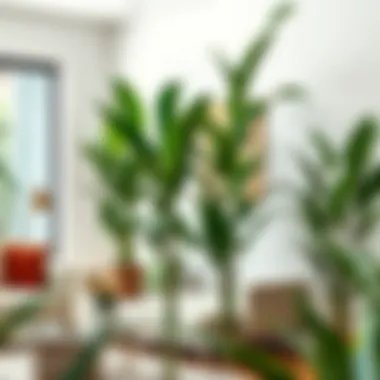

Choosing native plants for cultivation indoors can significantly reduce the ecological consequences associated with tall potted plants. Native plants are well-adapted to their environment, requiring less water and maintenance than non-native species. They thrive in local soil, often making them more resilient to pests and diseases, which means fewer chemicals and pesticides are necessary for their care. This further bolsters the sustainable choice by minimizing environmental toxicity.
Native plants not only enhance biodiversity but also provide essential habitat for local wildlife. By welcoming these plants into our homes, we nurture our ecosystem.
Why Go Native?
- Lower Maintenance: Native plants typically need less water, light, and attention than non-natives, making them easier for busy homeowners.
- Support Local Ecosystems: These plants can provide food and shelter for local birds and insects, which cultivates a balanced environment.
- Cultural Significance: Native plants often carry historical and cultural significance, connecting individuals to their regional heritage.
In summary, embracing sustainability in the realm of tall potted plants not only reflects an individual’s style but also showcases a commitment to protecting the planet. Sourcing eco-friendly pots and selecting native plants are strategic choices that contribute to a more sustainable future while enhancing interior spaces.
Integrating Technology
In the modern age, technology has found its way into virtually every aspect of our lives, including interior design. When it comes to tall potted plants, integrating technological solutions not only simplifies care but also enhances the aesthetic experience. With smart innovations, one can efficiently manage plant care, ensuring a vibrant indoor jungle without needing to be a green thumb. This section outlines how technology plays a pivotal role in the care and display of tall potted plants.
Smart Watering Systems
One of the key challenges of keeping tall potted plants thriving is consistent watering. Too much or too little water can be detrimental, affecting growth and health. This is where smart watering systems come into play. These systems employ sensors to monitor soil moisture levels and deliver the right amount of water as needed.
Some notable features include:
- Soil Sensors: They detect moisture levels and can send alerts directly to your phone if watering is needed.
- Automated Timers: Adjust schedules based on seasonal changes, ensuring that plants receive optimal care year-round.
- Smartphone Integration: Control watering remotely, allowing for flexibility while traveling or during busy periods.
Investing in a smart watering system can alleviate the guesswork involved in plant care. An efficient way to ensure your tall potted plants stay hydrated just the way they like it, reducing the risk of overwatering or drought.
Monitoring Plant Health
Beyond just watering, monitoring the overall health of tall potted plants is crucial. With advanced technology, various devices can now keep tabs on everything from humidity levels to ambient light.
Here are some aspects to consider:
- Light Sensors: Gauge the amount of natural light in the area, notifying you if a plant is not getting enough exposure. This way, adjustments can be made—like moving the plant or using grow lights—as necessary.
- Temperature and Humidity Monitors: These tools ensure your indoor climate matches the needs of your plants, as certain species may be more tolerant to different conditions.
- Plant Health Apps: Several mobile applications allow you to photograph and analyze plant health, offering tailored advice based on visual changes that might indicate distress.
By utilizing technology for monitoring, homeowners and designers alike can keep tall potted plants in prime condition, ensuring their beauty and health enhance the indoor environment for years to come.
"Integrating smart technology into plant care is not just about convenience; it's about observing a connection between nature and innovation, fostering healthier living spaces."
With these advancements, the daunting task of keeping indoor greenery thriving becomes more manageable, allowing you to enjoy the aesthetic and health benefits of your plants without the constant worry.
Common Mistakes in Choosing Tall Potted Plants
In the world of interior design, tall potted plants act not only as decorative elements but also serve to breathe life into various spaces. However, selecting the right plant for your environment is crucial, as making careless mistakes can negate the benefits these plants offer. Understanding common pitfalls can help homeowners, designers, and enthusiasts alike make informed decisions.
Overwatering Issues
One of the most frequently encountered mistakes is overwatering. It's like trying to give a fish a glass of water – it just doesn't work. Many newcomers to plant care assume that giving their plants more water equates to more health. This notion couldn’t be further from the truth. Overwatering can lead to root rot, a condition where roots begin to decompose due to lack of oxygen. When roots are suffocated, it’s a downward spiral that can lead to an unhappy plant and a hefty disappointment.
Signs of overwatering include:
- Yellowing leaves: When you see leaves turning yellow, especially at the base, take notice.
- Wilting: Ironically, an overwatered plant may also appear wilted, a cue that things are not going well.
- Mushy stems: Soft, mushy stems can indicate a significant problem with root rot.
To avoid this mistake:
- Check the soil frequently. A moisture meter can be quite handy for the task.
- Ensure that pots have proper drainage holes to let excess water escape. A plant sitting in water can be, for lack of a better word, a drowning plant.
Neglecting Light Needs
Another common oversight is neglecting the light needs of the plant. Each type of tall potted plant has a specific requirement for light, and failing to cater to this can spell disaster. Imagine a sunflower in a dark room, lacking sunshine. It’s bound for disappointment.
Understanding the light conditions in your space is essential. For example, the Fiddle Leaf Fig thrives in bright, indirect light, while the Rubber Plant can adjust to moderate lighting conditions. Not considering these elements can lead to stunted growth or a plant that simply refuses to flourish.
Tips to address light needs:
- Analyze your living space. Does it get direct sunlight, or is it more shaded?
- Position your plants accordingly. If a plant requires full sun, place it near windows that get ample exposure.
- Rotate plants occasionally. In doing so, you can promote even growth and prevent leaning toward light sources.
"The right light can make or break your green friend’s wellbeing. Consider it a vital ingredient in the recipe of thriving plants."
In summary, preventing these common mistakes can greatly enhance your experience with tall potted plants. By being mindful of overwatering and light needs, you position your plants to thrive and contribute positively to your interior spaces.
End
In closing, tall potted plants serve not only as aesthetic enhancements to modern interiors but also as vital components in creating a healthier living environment. Their presence brings forth a variety of benefits, which can uplift the mood within any space while also improving air quality. As we’ve delved into throughout this article, the thoughtful integration of these plants allows for a blend of functionality and beauty, making them indispensable for contemporary home design.
Summary of Key Points
First and foremost, we outlined how the visual impact of tall potted plants can transform the perception of space. Whether placed strategically in corners or used as bold statements in open areas, their stature and foliage draw eyes and create focal points that anchor the room's design. We also discussed their role in complementing various styles, from the sleek lines of modern minimalism to the free-spirited air of bohemian chic, showcasing their versatility in any context.
Moreover, the functional advantages of these plants cannot be overstated. They help regulate temperature and improve air quality, which can be crucial in urban homes where natural ventilation might be lacking.
Selecting the right species and understanding their unique care requirements is essential, as we elaborated in previous sections. Every plant has its own personality, and matching that with the light and moisture conditions of a given space is vital for long-term sustainability.
Encouraging Thoughtful Plant Selection
When it comes to choosing tall potted plants, adopting a considerate approach is paramount. Homeowners, designers, and enthusiasts alike should take time to assess their unique environments. It's essential to reflect on not just the aesthetic appeal but also on how different species will thrive in the available light and room conditions.
Furthermore, sourcing plants from local nurseries can promote native flora and support community businesses. This ensures that the plants are more likely to adapt well to the local climate and conditions, enhancing the longevity of their presence in your home.
In summary, tall potted plants are more than just mere decorations. When selected and maintained thoughtfully, they can enrich interior spaces, promote health, and create harmonious living environments.





